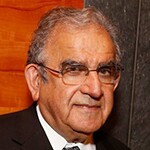A new center at USC Viterbi School of Engineering, the Ershaghi Center for Energy Transition (E-CET), will bring together thought leaders from academia and industry to collaborate on research and educational programs that will foster an energy transition toward a low-carbon future. The interdisciplinary center, supported by a gift from USC Viterbi and Marshall alumnus Gary Buntmann and his wife, Mary Buntmann, will focus on cultivating effective technologies and methods in a number of processes, including: re-engineering oil and gas development processes and operations to reduce carbon intensity and carbon footprint and repurposing idle oil and gas wells to help the storage of renewable energy in subsurface geological structure and substantially help in the recovery of geothermal heat.

The center is named to honor engineering Professor Iraj Ershaghi, who this year completes 50 years as a faculty member at USC. Throughout his distinguished career, he taught and mentored thousands of USC engineering students and contributed to outstanding research that led to his induction in 2014 into the National Academy of Engineering.
“The transition to a future powered by renewable energy technologies is an urgent necessity, to help maintain a planet which is sustainable, healthy, and secure for all humanity,” said USC Viterbi School of Engineering Dean Yannis C. Yortsos.
“Developing the means for such a transition requires a focused effort in education and research, which the new center will endeavor to provide. It is entirely fitting that the new center, funded by the generosity of Gary and Mary Buntmann, honors an exceptional, dedicated USC colleague, Professor Iraj Ershaghi, who has distinguished himself in hydrocarbon energy field for many decades, and now will focus his energy and talent in accelerating the energy transition toward a sustainable future.”
Buntmann, the founder of Crimson Resource Management, said, “The viability of the future in global transitional energy begins with breakthrough science and cutting-edge education of those entrusted to implement. USC Viterbi is an extremely capable leader in the area of engineering innovation and is well-suited to embark on this extremely important initiative. I am proud and humbled to have Dr. Ershaghi as the namesake for the USC-CET to cultivate the next generation of transitional energy engineering professionals.”
Ershaghi added, “Through this initiative, USC Viterbi will be at the forefront of institutions that educate engineering students who develop impactful solutions to the major challenge of energy transition for the current and future generations.”
In addition to supporting such energy-focused engineers with fellowships and research opportunities, E-CET will bring together and support research of faculty in the energy, materials science, data science, and artificial intelligence fields. In addition, the center will seek industry collaboration to advance pressing issues related to renewable energy storage.
A longtime, active member of the Society of Petroleum Engineers, Ershaghi has received many SPE awards, including Legion of Honor (2016); Honorary Membership (2012); John Franklin Carll Award (2010); Regional Reservoir Description and Dynamics Award-Western Region North America (2007); Regional Service Award-Western Region North America (2005); Distinguished Membership (1996); and Distinguished Achievement Award for Petroleum Engineering Faculty (1983). His research areas include well test modeling of complex naturally fractured reservoirs, pattern recognition techniques for monitoring water floods and EOR processes, reservoir characterization, unconventional resources, and soft computing concepts in digital oilfield design and operations. He has worked for SIRIP, Signal Oil and Gas, California State Lands Commission, and has served as a consultant to the US Department of Justice, US Department of Interior, Chemical Research Laboratories, McFarland Energy, National Bureau of Standards, CRC, and many others.

